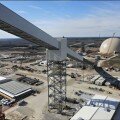More than 40 chemical engineering students from Mississippi State University’s School of Engineering recently spent an afternoon touring the Kemper County Energy Facility. Because the Kemper plant is bringing new types of highly-skilled jobs to Mississippi with its first-of-a-kind technology, finding local applicants to fill those highly-specialized careers remains a long-term priority for Mississippi Power.
“I’m glad Mississippi has such an advanced plant,” Dr. Mark Bricka, an MSU engineering instructor, said after his first visit to the Kemper IGCC project. “Most of our students end up going to Texas and Louisiana, about 80 percent. This will offer many more opportunities for them.”
Kemper Process Engineer and Controls Manager Carson Brown walked the students through the inter-workings of the Kemper plant as well as took them on a tour of the facility’s coal drying, gasification and process air areas. Students also discussed planning, execution and challenges posed when implementing large transformational projects like Kemper.
“It’s right on target,” Bricka said of the visit. “What we’ve been learning in class is pretty much what we’ve heard in the brief and tour here today.”
Rachael Fouasnon said she had heard about the facility before her visit, including some of the criticisms. However, from the standpoint of an engineering student studying how to improve efficiency and plan for the future, the project takes a whole new meaning.
“A plant that can make its own utility and recycle carbon is pretty great,” she said. “Recycling raw materials to get the most out of cost is very efficient.”
The students also toured the adjacent Liberty Mine to see the lignite mining process and land reclamation procedure.
Of most interest to MSU’s chemical engineering class is the way the plant will chemically refine the lignite gas and remove carbon dioxide, sulfur and other substances that would normally be a pollutant, turning them into staple chemical products that can be resold to various industrial customers. This includes oil companies who’ll use the captured carbon dioxide to increase America’s domestic oil production.
“The best way Mississippi can reduce carbon dioxide emissions is to utilize our lignite resources in a coal gasification facility like this,” student Alex Schesny said. “But not only that, it’ll give Mississippians more opportunities for good-paying jobs, in addition to a cleaner environment.”





 #Kemper is capable of producing much cleaner energy from coal, that’s why energy leaders are watching so closely.
#Kemper is capable of producing much cleaner energy from coal, that’s why energy leaders are watching so closely.